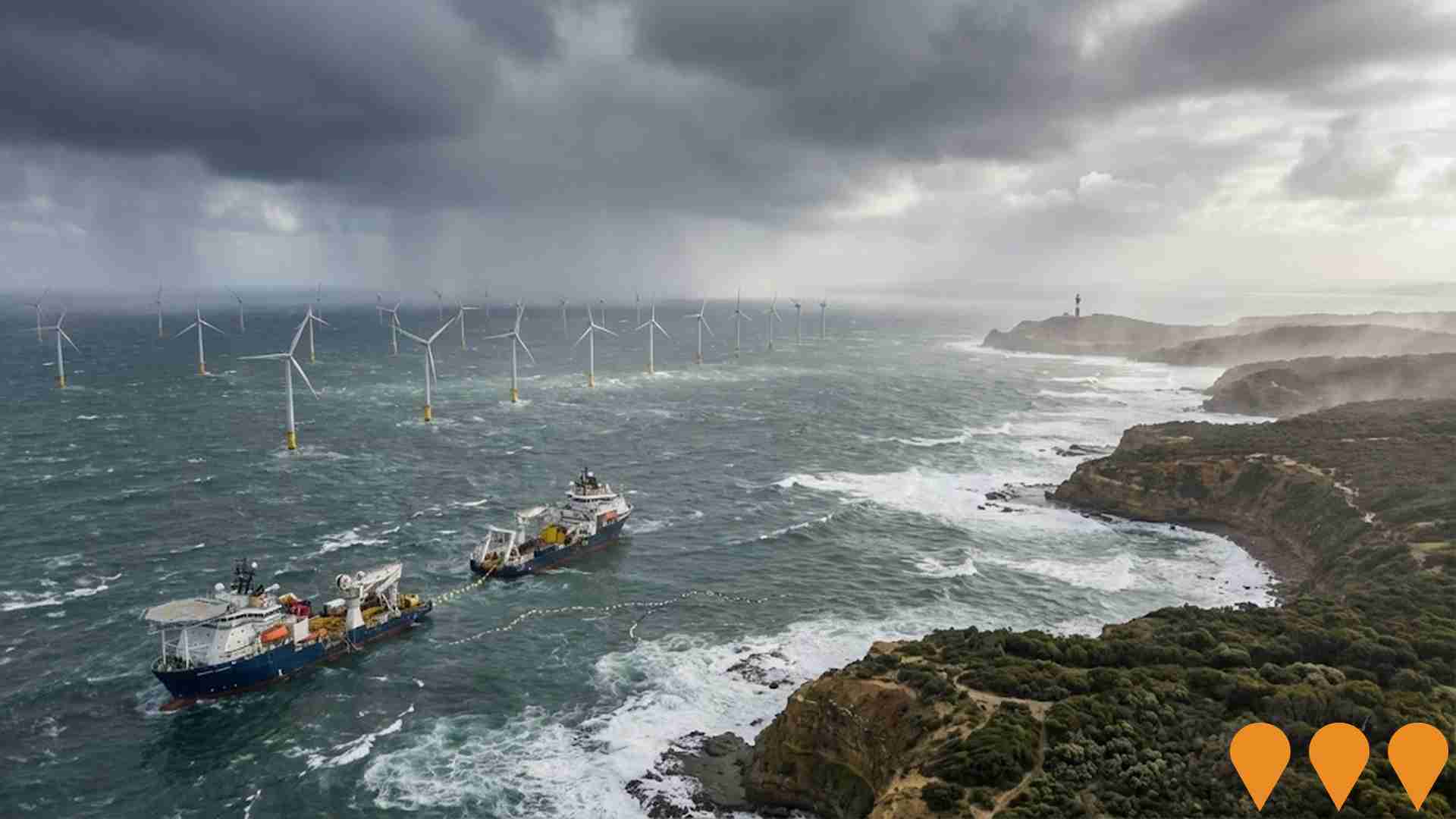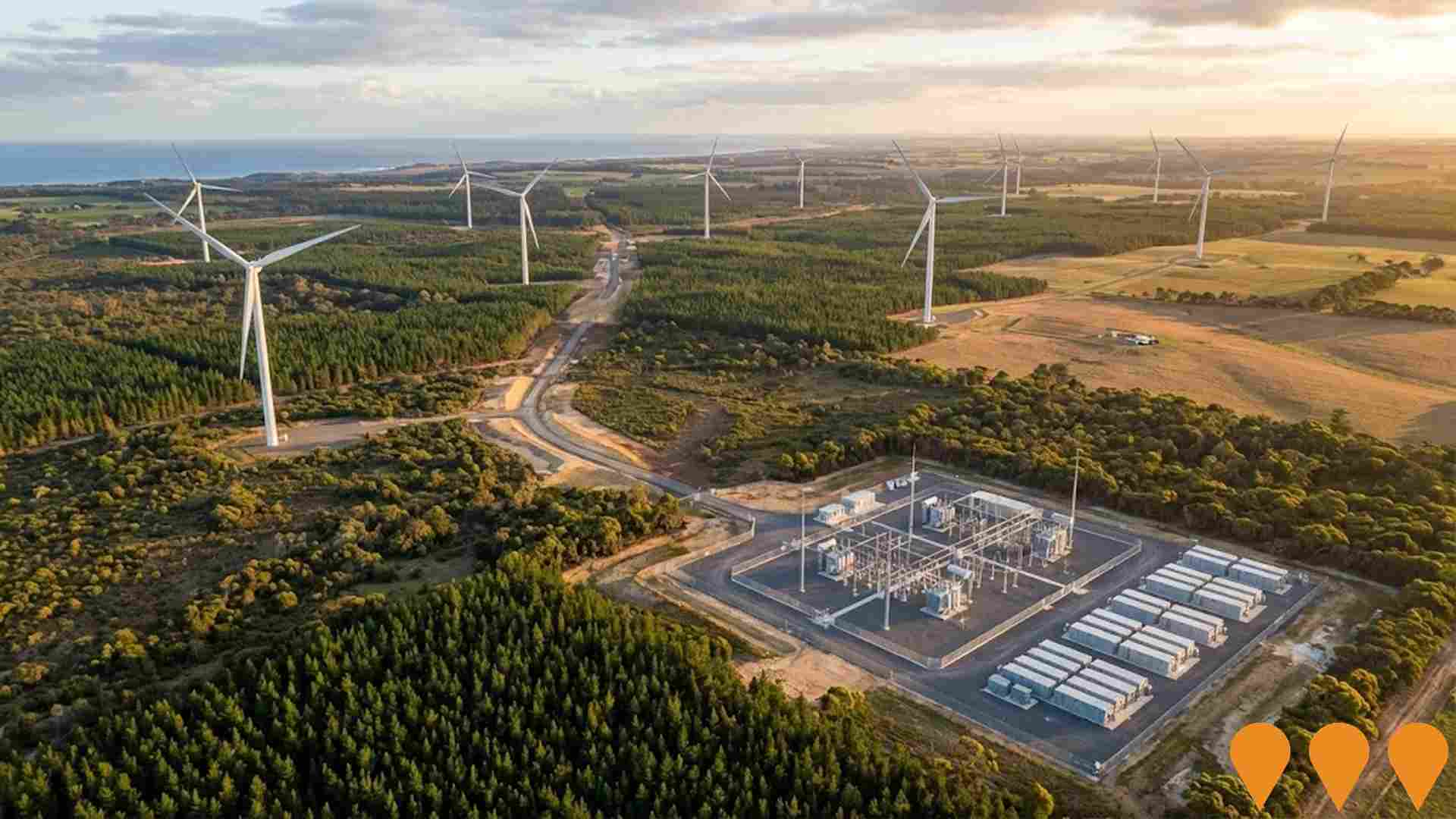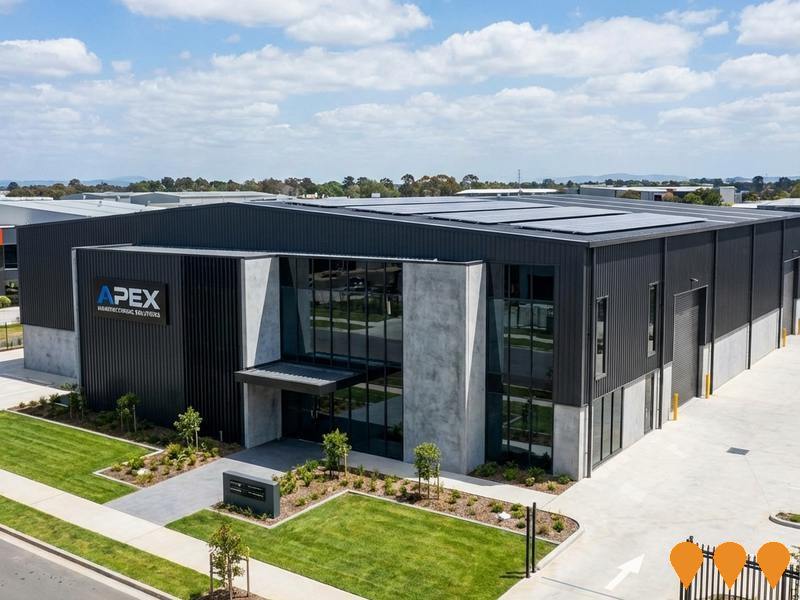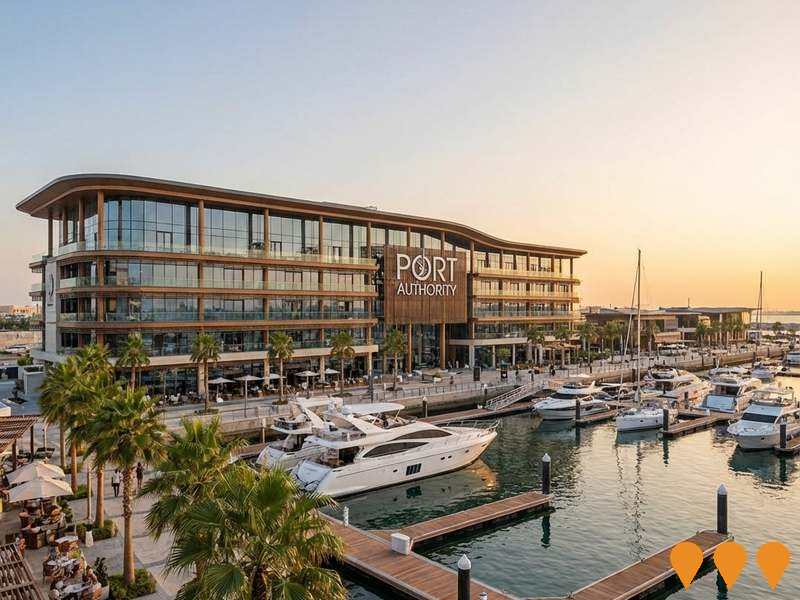Chart Color Schemes
est. as @ -- *
ABS ERP | -- people | --
2021 Census | -- people
Sales Activity
Curious about local property values? Filter the chart to assess the volume and appreciation (including resales) trends and regional comparisons, or scroll to the map below view this information at an individual property level.
Find a Recent Sale
Sales Detail
Population
Glenelg is positioned among the lower quartile of areas assessed nationally for population growth based on AreaSearch's assessment of recent, and medium term trends
Glenelg's population, as per AreaSearch's analysis, is approximately 8,952 as of August 2025. This figure represents an increase of 32 people since the 2021 Census, which recorded a population of 8,920. The change is inferred from the estimated resident population of 8,867 in June 2024 and the addition of 75 validated new addresses since the Census date. This results in a population density ratio of 1.5 persons per square kilometer. Glenelg's growth rate of 0.4% since the census is comparable to its SA3 area, indicating strong growth fundamentals. Overseas migration was the primary driver of population growth during recent periods.
AreaSearch uses ABS/Geoscience Australia projections for each SA2 area, released in 2024 with a base year of 2022. For areas not covered by this data, AreaSearch employs VIC State Government's Regional/LGA projections from 2023, adjusted using weighted aggregation methods to SA2 levels. Growth rates by age group are applied across all areas for the years 2032 to 2041. By 2041, Glenelg is projected to increase by approximately 482 persons, reflecting a total growth of about 4.0% over the 17-year period.
Frequently Asked Questions - Population
Development
AreaSearch assessment of residential development drivers sees a low level of activity in Glenelg, placing the area among the bottom 25% of areas assessed nationally
Glenelg has received approximately 26 dwelling approvals each year over the past five financial years, totalling 130 homes. As of FY-26, three approvals have been recorded. Despite a decline in population during this period, housing supply has remained adequate relative to demand, resulting in a balanced market with good buyer choice. The average expected construction cost value for new homes is $367,000, which is below regional norms, indicating more affordable housing options.
In FY-26, $9.2 million in commercial approvals have been registered, suggesting steady commercial investment activity. Compared to the rest of Victoria, Glenelg has 15.0% less new development per person and ranks among the 36th percentile nationally, leading to relatively constrained buyer choice and supporting interest in existing properties. This is also lower than the national average, reflecting market maturity and potential development constraints. Recent building activity consists solely of detached dwellings, maintaining Glenelg's traditional low-density character with a focus on family homes appealing to those seeking space.
The estimated population per dwelling approval is 468 people, indicating a quiet, low-activity development environment. Looking ahead, Glenelg is projected to grow by 362 residents by 2041. At current development rates, new housing supply should comfortably meet demand, providing good conditions for buyers and potentially supporting growth beyond current population projections.
Frequently Asked Questions - Development
Infrastructure
Glenelg has emerging levels of nearby infrastructure activity, ranking in the 31stth percentile nationally
Changes to local infrastructure significantly impact an area's performance. AreaSearch has identified 17 projects that could affect this region. Notable projects include Budj Bim Cultural Landscape Infrastructure, Kentbruck Green Power Hub, Tyrendarra Town Area Restructure Plan, and Settlers Rd, Tyrendarra - Roads to Recovery Project. The following list details those most relevant.
Professional plan users can use the search below to filter and access additional projects.
INFRASTRUCTURE SEARCH
 Denotes AI-based impression for illustrative purposes only, not to be taken as definitive under any circumstances. Please follow links and conduct other investigations from the project's source for actual imagery. Developers and project owners wishing us to use original imagery please Contact Us and we will do so.
Denotes AI-based impression for illustrative purposes only, not to be taken as definitive under any circumstances. Please follow links and conduct other investigations from the project's source for actual imagery. Developers and project owners wishing us to use original imagery please Contact Us and we will do so.
Frequently Asked Questions - Infrastructure
Cape Winds Offshore Windfarm
Proposed offshore wind project located in Discovery Bay between Portland and Nelson, Victoria. The concept targets up to 2,000 MW with fixed-bottom turbines, subsea export cables, and an onshore substation connection into the NEM. The project was referred for environmental assessment in August 2021 under Victoria's EES and the Commonwealth EPBC Act. As of 2025 no feasibility licence has been granted and approvals are not in place.

Kentbruck Green Power Hub
Proposed 600 MW onshore wind farm of up to 105 turbines near Nelson/Portland in south-west Victoria, with an underground 275 kV transmission line to Heywood Terminal Station, on-site substations and potential co-located battery storage. The project completed EES exhibition (Jan-Mar 2025); public hearings concluded 24 Jul 2025 and the IAC report is pending Ministerial decision. Ownership of the Victorian portfolio including Kentbruck transferred from Neoen to HMC Capital in Dec 2024.

Budj Bim Cultural Landscape Infrastructure
Tourism and cultural infrastructure delivered across five sites in the Budj Bim Cultural Landscape — Tyrendarra Recreation Reserve, Tyrendarra IPA, Kurtonitj IPA, Tae Rak (Lake Condah) and Budj Bim National Park — including the Tae Rak Aquaculture Centre, visitor facilities, boardwalks, shelters, jetty and lookout. Works support sustainable access, protection of World Heritage values and guided cultural tourism led by Gunditjmara Traditional Owners.

Portland North Employment Precinct
The Portland North Employment Precinct is a 10-hectare development aimed at boosting the local economy through job creation and business attraction. Bunnings Warehouse, the anchor tenant, opened in June 2025, creating over 50 ongoing jobs and supporting 50 during construction. Funded by $2.5 million from the Victorian Government, the precinct positions Portland as a key economic centre in south west Victoria.

Portland Energy Park
A 1,000MW / 2,500MWh battery energy storage park comprising four grid-scale co-located battery assets to capture excess renewable energy, enhance grid stability, and support Victoria's transition to net-zero emissions by avoiding approximately 66,900 tonnes of CO2 annually and powering 182,000 homes daily.

Portland Renewable Fuels Project
A world-scale renewable methanol development in Portland, Victoria, converting residual forestry biomass and renewable electricity into green methanol using a 200-megawatt electrolyser, producing 300,000 tonnes annually and avoiding 320,000 tonnes of CO2 emissions per year.

Housing Manufacturing Hub
A $2.35 million manufacturing hub at Portland Airport developed by FormFlow to produce up to 200 relocatable modular houses per year, addressing housing shortages in Victoria's Great South Coast region. The project aims to create 50 direct and 150 indirect jobs but was paused in October 2023 due to industry pressures, with the lease remaining active as of 2025.

Portland Foreshore Multipurpose Facility
Refurbishment of the Portland Yacht Club and Portland Sport Fishing Club buildings on the Portland Foreshore to provide all-abilities access, meet building codes, comply with regulations, extend building life, and reduce maintenance costs.

Employment
AreaSearch analysis places Glenelg well above average for employment performance across multiple indicators
Glenelg Vic. has a balanced workforce with white and blue collar jobs, diverse sectors represented, and an unemployment rate of 1.7% as of June 2025.
There are 4,373 residents employed, with an unemployment rate 2.1% below Rest of Vic.'s 3.8%, and workforce participation similar to Rest of Vic.'s 57.4%. Key industries include agriculture, forestry & fishing, health care & social assistance, retail trade. Agriculture, forestry & fishing has notable concentration, with employment levels at 3.5 times the regional average. Education & training shows lower representation at 5.5% versus regional average of 9.1%.
The area offers limited local employment opportunities, indicated by Census working population vs resident population count. Between June 2024 and June 2025, labour force levels decreased by 1.8%, combined with employment decreasing by 1.4%, resulting in unemployment rate falling by 0.4 percentage points. In Rest of Vic., employment fell by 0.9%, labour force contracted by 0.4%, and unemployment rose 0.4 percentage points. Jobs and Skills Australia's national employment forecasts from May 2025 project national employment growth of 6.6% over five years and 13.7% over ten years, with differing growth rates between sectors. Applying these projections to Glenelg's employment mix suggests local growth of approximately 5.3% over five years and 11.8% over ten years, though these are simple weighting extrapolations for illustrative purposes only.
Frequently Asked Questions - Employment
Income
Income figures position the area below 75% of locations analysed nationally by AreaSearch
Glenelg's median income among taxpayers in financial year 2022 was $46,673. The average income stood at $58,305 during the same period. In comparison, Rest of Vic.'s median and average incomes were $48,741 and $60,693 respectively. As of September 2025, current estimates for Glenelg's median and average incomes are approximately $52,348 and $65,395 respectively, based on Wage Price Index growth of 12.16% since financial year 2022. According to the 2021 Census, household, family, and personal incomes in Glenelg fell between the 16th and 20th percentiles nationally. The largest segment comprised 28.0% earning $1,500 - $2,999 weekly, with 2,506 residents falling into this bracket, mirroring regional levels where 30.3% occupied this bracket. Housing costs in Glenelg were modest, with 91.8% of income retained. However, the total disposable income ranked at just the 24th percentile nationally.
Frequently Asked Questions - Income
Housing
Glenelg is characterized by a predominantly suburban housing profile, with above-average rates of outright home ownership
Glenelg's dwelling structure, as per the latest Census, consisted of 96.9% houses and 3.1% other dwellings. In comparison, Non-Metro Vic. had 93.1% houses and 6.8% other dwellings. Home ownership in Glenelg stood at 55.8%, with mortgaged properties at 31.4% and rented ones at 12.8%. The median monthly mortgage repayment was $1,073, lower than Non-Metro Vic.'s average of $1,083. The median weekly rent in Glenelg was $180, compared to Non-Metro Vic.'s $220. Nationally, Glenelg's mortgage repayments were significantly lower at $1,073 than the Australian average of $1,863, while rents were substantially below the national figure of $375.
Frequently Asked Questions - Housing
Household Composition
Glenelg features high concentrations of lone person households, with a fairly typical median household size
Family households constitute 66.7% of all households, including 23.3% couples with children, 35.2% couples without children, and 7.3% single parent families. Non-family households account for the remaining 33.3%, with lone person households at 30.9% and group households comprising 2.3% of the total. The median household size is 2.2 people, which aligns with the average in the Rest of Vic.
Frequently Asked Questions - Households
Local Schools & Education
Glenelg faces educational challenges, with performance metrics placing it in the bottom quartile of areas assessed nationally
The area's university qualification rate is 13.9%, significantly lower than Victoria's average of 33.4%. This gap presents both a challenge and an opportunity for targeted educational initiatives. Bachelor degrees are the most common, at 9.6%, followed by graduate diplomas (2.2%) and postgraduate qualifications (2.1%). Vocational credentials are prominent, with 41.1% of residents aged 15+ holding them - advanced diplomas (9.7%) and certificates (31.4%).
A total of 24.8% of the population is actively pursuing formal education, including 9.3% in primary, 8.1% in secondary, and 1.9% in tertiary education. Glenelg has a robust network of 9 schools serving approximately 572 students, with typical Australian school conditions (ICSEA: 961) and balanced educational opportunities. The area has 7 primary and 2 secondary schools serving distinct age groups. However, local school capacity is limited (6.4 places per 100 residents vs 14.1 regionally), leading many families to travel to nearby areas for schooling.
Frequently Asked Questions - Education
Schools Detail
Nearby Services & Amenities
Transport
Transport servicing is very low compared to other areas nationally based on assessment of service frequency, route connectivity and accessibility
Analysis of Glenelg's public transport shows 18 operational stops, all bus services. These are covered by nine routes offering 61 weekly passenger trips in total. Residents' access to transport is rated limited, with an average distance of 4054 meters to the nearest stop.
Service frequency averages eight trips daily across all routes, equating to roughly three weekly trips per individual stop.
Frequently Asked Questions - Transport
Transport Stops Detail
Health
Health performance in Glenelg is well below average with prevalence of common health conditions notable across both younger and older age cohorts
Health data indicates significant challenges for Glenelg, with high prevalence of common health conditions across both younger and older age groups. Approximately 49% (~4,377 people) have private health cover, lower than the national average of 55.3%.
The most prevalent medical conditions are arthritis (12.0%) and mental health issues (8.1%). 63.3% report being free from medical ailments, compared to 62.4% in Rest of Vic. Glenelg has a higher proportion of seniors aged 65 and over at 27.8% (2,488 people), versus 26.3% in Rest of Vic. Senior health outcomes are above average, outperforming the general population in health metrics.
Frequently Asked Questions - Health
Cultural Diversity
The latest Census data sees Glenelg placing among the least culturally diverse areas in the country when compared across a range of language and cultural background related metrics
Glenelg, as per the census conducted on 27 June 2016, showed low cultural diversity. 89.8% of its population were Australian citizens, with 91.3% born in Australia and 97.6% speaking English at home only. Christianity was the predominant religion, accounting for 48.5% of Glenelg's population, compared to 50.5% across Victoria.
The top three ancestry groups were Australian (33.3%), English (32.9%), and Scottish (9.7%). Notably, Dutch (1.5%) and Maltese (0.6%) were overrepresented in Glenelg compared to regional averages of 1.4% and 0.4%, respectively. Irish ancestry also showed a slight overrepresentation at 9.3%.
Frequently Asked Questions - Diversity
Age
Glenelg ranks among the oldest 10% of areas nationwide
Glenelg has a median age of 50, which is higher than Rest of Vic's figure of 43 and well above the national average of 38. The 65-74 age group comprises 16.2% of Glenelg's population, compared to Rest of Vic's percentage, while the 25-34 cohort makes up 8.6%. This 65-74 concentration is higher than the national figure of 9.4%. According to the 2021 Census, the 15-24 age group increased from 8.6% to 9.9%, and the 35-44 cohort rose from 9.6% to 10.8%. Conversely, the 55-64 cohort decreased from 17.7% to 16.1%, and the 45-54 group fell from 13.3% to 11.8%. Demographic modeling indicates that Glenelg's age profile will significantly change by 2041. The 25-34 age cohort is projected to grow by 204 people (27%), from 765 to 970, while population declines are expected for the 65-74 and 15-24 cohorts.




